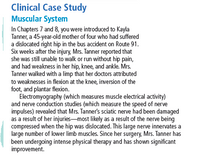
Concept explainers
1. During her initial visit with the physical therapist, Mrs. Tanner presented with significant “foot drop” (the inability to dorsiflex the foot when taking a step). Mrs. Tanner was asked to perform a variety of movements with her right lower extremity. The therapist focused her attention on the prime movers and synergists of the hip, knee, and ankle. What are “prime movers” and “synergists”? 2. In order to assess the function and strength of a specific muscle, a physical therapist will often apply resistance (push against the moving limb) to mimic the action of an antagonist muscle. What is an antagonist muscle, and why would the therapist mimic its action? 3. Mrs. Tanner’s physical therapist performed a variety of assessments in order to establish a baseline from which her recovery could be measured. For each of the descriptions below, name the muscle (or muscles) that the therapist was assessing. a. With Mrs. Tanner in the seated position, the therapist positioned Mrs. Tanner’s legs shoulder-width apart, then asked Mrs. Tanner to bring her feet together while the therapist applied resistance to the right leg. b. The therapist applied resistance to the top of Mrs. Tanner’s foot and asked her to pull her forefoot up toward her shin. c. With Mrs. Tanner in the prone position (on her stomach), the therapist applied resistance to the leg while Mrs. Tanner was instructed to bring her heel up toward her buttocks (flex her knee). 4. Using descriptions similar to those listed in the question above, explain how you would assess the function of the following muscles. a. Extensor hallucis longus b.Fibularis (peroneus) longus c. Gastrocnemius

Trending nowThis is a popular solution!
Step by stepSolved in 3 steps

- 1. In the human body...bones: lever, and the 5 = is the force. of a lever. The joint is the What is the most common lever system in the human body-2 1st? 2nd2 3rd? of a Uarrow_forward1. Place the following in their order of use during a knee arthroscopy: blunt trocar, irrigation/inflow cannula, sharp trocar, #11 knife blade. 2. What is the difference between a Steinmann pin and a K-wire? 3. What is the difference in structure between a cortical and cancellous screw? 4. What is the purpose of placing a cement restrictor within the femur during a total hip arthroplasty? 5. What safety steps should be followed when using cement in orthopedic procedures?arrow_forward2. Write down the muscles of the forearm selected by your instructor and, for each, give the location of that muscle and what effect contracting that muscle has. Muscle Location & description Action(s)arrow_forward
- 1.What types of joint movement (hip flexion, extension, etc.) occur during walking?arrow_forward24. Muscles that originate on the posterior of the femur and insert on the posterior of the tibia will generally perform this(ese) motion(s). D - knee flexion B and C C - knee extension B - hip flexion A - hip extension A and Darrow_forward4. Explain the mechanism of the arm abduction and adduction at the shoulder joint together with the respective muscles involved in the body movementarrow_forward
- 2 W F2 # 3 Name an activity you could do in daily life that uses the same movement as over and unde STRETCH BAND LATERAL RAISES Bones Muscles Joint type(s) Movement(s) Name an activity you could do in daily life that uses the same movement as lateral raise: DUMBBELL FRONT SQUAT Bones E Muscles 6,876 Joint type(s) Movement(s) Name an activity you could do in daily life that uses the same movement as front squat: 80 F3 DEC 7 SA 4 a F4 R A % 5 F5 I T 6 W MacBook Air C F6 ☆ Y & 7 ♫ F7 U * 8 F8 P ( 9 Farrow_forward6. Mr.Grady is recording his walking achievememts in a rehab program. His goal is to walk 8km this week. So far, he has walked 1 km, 1 km, 1 km, and 1 km. How many km 2 are left for him to walk in order to meet his goal for this week?arrow_forward
 Phlebotomy EssentialsNursingISBN:9781451194524Author:Ruth McCall, Cathee M. Tankersley MT(ASCP)Publisher:JONES+BARTLETT PUBLISHERS, INC.
Phlebotomy EssentialsNursingISBN:9781451194524Author:Ruth McCall, Cathee M. Tankersley MT(ASCP)Publisher:JONES+BARTLETT PUBLISHERS, INC. Gould's Pathophysiology for the Health Profession...NursingISBN:9780323414425Author:Robert J Hubert BSPublisher:Saunders
Gould's Pathophysiology for the Health Profession...NursingISBN:9780323414425Author:Robert J Hubert BSPublisher:Saunders Fundamentals Of NursingNursingISBN:9781496362179Author:Taylor, Carol (carol R.), LYNN, Pamela (pamela Barbara), Bartlett, Jennifer L.Publisher:Wolters Kluwer,
Fundamentals Of NursingNursingISBN:9781496362179Author:Taylor, Carol (carol R.), LYNN, Pamela (pamela Barbara), Bartlett, Jennifer L.Publisher:Wolters Kluwer, Fundamentals of Nursing, 9eNursingISBN:9780323327404Author:Patricia A. Potter RN MSN PhD FAAN, Anne Griffin Perry RN EdD FAAN, Patricia Stockert RN BSN MS PhD, Amy Hall RN BSN MS PhD CNEPublisher:Elsevier Science
Fundamentals of Nursing, 9eNursingISBN:9780323327404Author:Patricia A. Potter RN MSN PhD FAAN, Anne Griffin Perry RN EdD FAAN, Patricia Stockert RN BSN MS PhD, Amy Hall RN BSN MS PhD CNEPublisher:Elsevier Science Study Guide for Gould's Pathophysiology for the H...NursingISBN:9780323414142Author:Hubert BS, Robert J; VanMeter PhD, Karin C.Publisher:Saunders
Study Guide for Gould's Pathophysiology for the H...NursingISBN:9780323414142Author:Hubert BS, Robert J; VanMeter PhD, Karin C.Publisher:Saunders Issues and Ethics in the Helping Professions (Min...NursingISBN:9781337406291Author:Gerald Corey, Marianne Schneider Corey, Cindy CoreyPublisher:Cengage Learning
Issues and Ethics in the Helping Professions (Min...NursingISBN:9781337406291Author:Gerald Corey, Marianne Schneider Corey, Cindy CoreyPublisher:Cengage Learning





